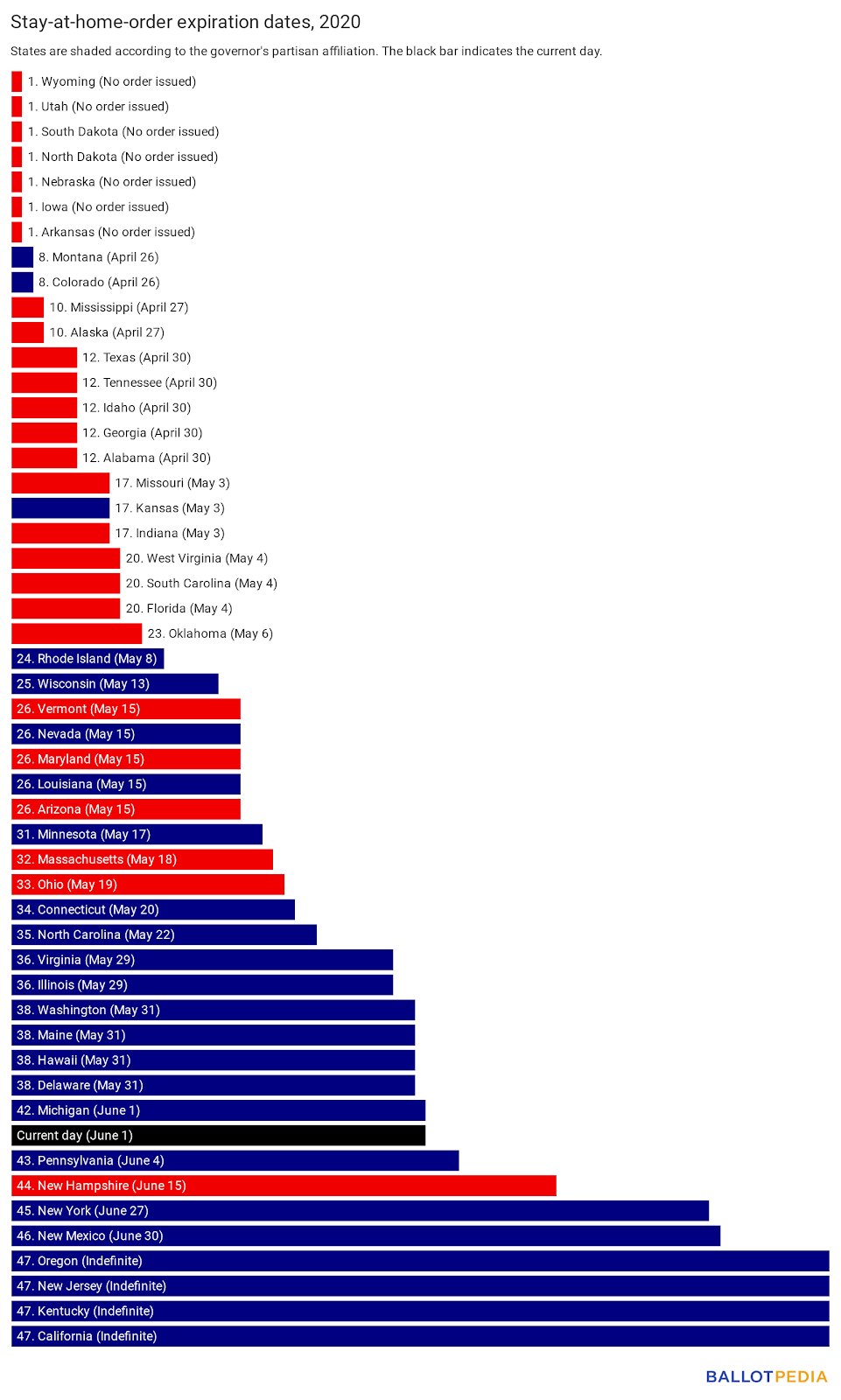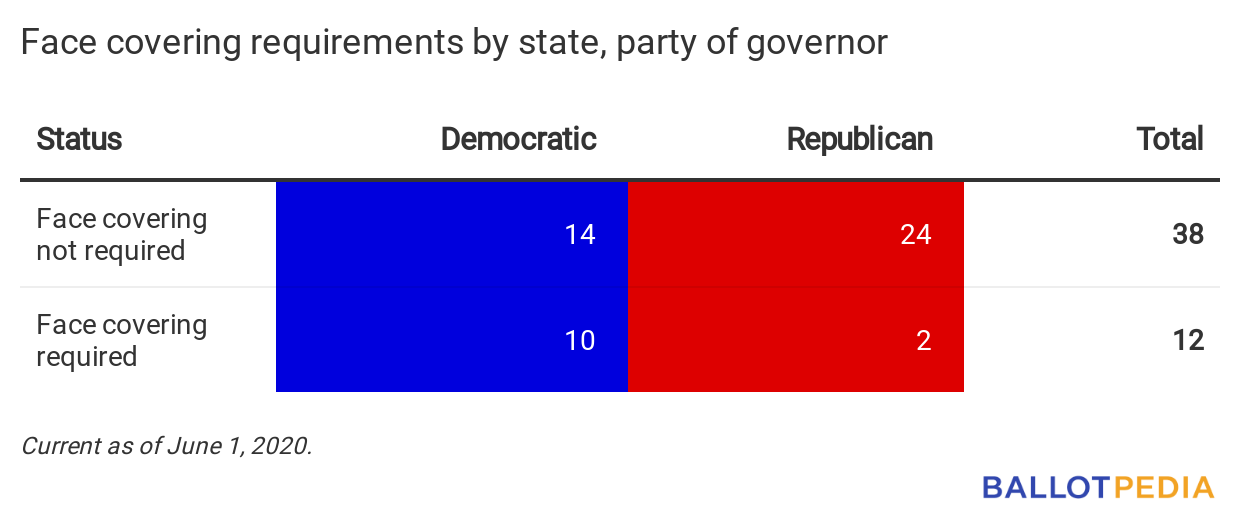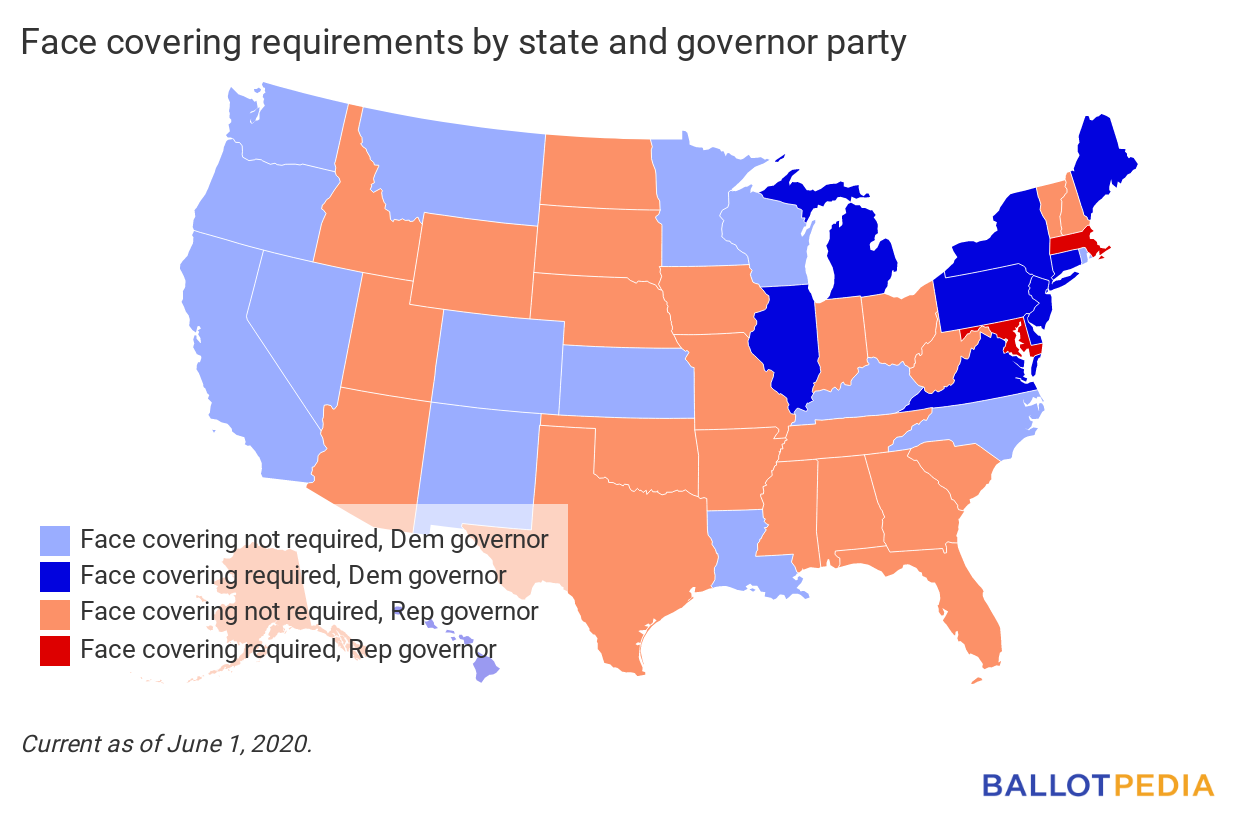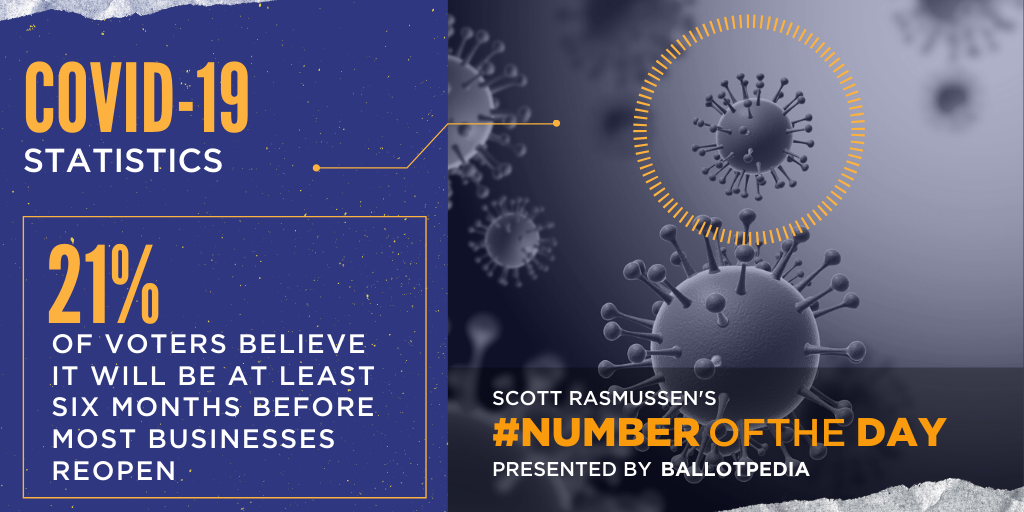 Each day, we:
Each day, we:
- Track the status of reopening in all 50 states.
- Compare the status of one industry or activity across the country.
- Provide in-depth summaries of the latest reopening plans.
- Give you the latest stories on other reopening plans and ideas.
Want to know what happened Friday? Click here.
The next two days
What is reopening in the next two days? Which stay-at-home orders will expire?
- Louisiana (divided government): Gov. John Bel Edwards (D) was scheduled to hold a media briefing at 2:30 p.m. local time, June 1. He is expected to make an announcement on the prospect of further reopenings. We will have more details in Tuesday’s edition.
- Massachusetts (divided government): Gov. Charlie Baker (R) is expected to issue an executive order on June 1 outlining which business sectors will be allowed to resume operations in each phase of the state’s reopening. We will have more details in Tuesday’s edition. Baker said a decision on the start date for Phase 2 would come on June 6.
Since our last edition
Have any states opened? For a continually updated article on reopening status in all 50 states, click here. For our last edition, click here.
- Arkansas (Republican trifecta): The Arkansas Department of Health announced that community and school-sponsored team sports could resume beginning June 1. Bands are allowed to resume marching activities without wind instruments. College athletics are not included in this reopening.
- Arizona (Republican trifecta): The Department of Education released its 36-page “Roadmap for Reopening Schools.” The document covers four different scenarios: in-person instruction from the beginning of the year, some students distance learning and some students learning in-person at the start of the year, all students distance learning at the start of the year, and intermittent distance learning throughout the year, depending on local conditions.
- Delaware (Democratic trifecta): The state’s stay-at-home order expired on May 31. The order first took effect on March 24. Delaware was the 16th state to enact a stay-at-home order and was the 31st state to end its stay-at-home order (along with others that ended on May 31).
- Hawaii (Democratic trifecta): The state entered the Act with Care phase of reopening. On June 1, Hawaii and Maui counties are opening personal care services (like salons and barbershops) and dine-in services at restaurants. Hawaii County also began opening places of worship. The state’s stay-at-home order expired on May 31, making it the 31st state to end a stay-at-home order (along with others that ended on May 31).
- Idaho (Republican trifecta): The state moved into its third phase of reopening on May 30. Phase Three allows non-essential travel and gatherings of up to 50 people. Businesses like bars and movie theaters can reopen. Larger venues like nightclubs and stadiums remain closed.
- Mississippi (Republican trifecta): Gov. Tate Reeves’ (R) Safe Return order took effect on June 1. The order allows all travel to resume. It also permits indoor gatherings of up to 20 people and outdoor gatherings of up to 50 people. If social distancing is possible, indoor gatherings of up to 50 and outdoor gatherings of up to 100 are allowed. Ballparks, theaters, libraries, and museums can also begin opening.
- Iowa (Republican trifecta): On June 1, outdoor performance venues, casinos, bowling alleys, amusement parks, skating rinks, skate parks, and outdoor playgrounds are allowed to reopen at 50% capacity. Summer school activities, including baseball and softball, are also allowed to resume.
- Kentucky (divided government): On June 1, the following businesses are allowed to reopen: auctions (33% capacity), auto/dirt track racing, aquatic centers, bowling alleys, fishing tournaments, fitness centers (33% capacity), state park lodges, movie theaters (33% capacity), and the Salato Wildlife Education Center.
- Maine (Democratic trifecta): On May 31, Gov. Janet Mills (D) issued an executive order easing the original stay-at-home order “to the extent that people may access the increased business and personal activities that are being reopened.” The order says “persons who are over age 60 or who have a medically compromised condition are strongly urged to limit their movement and activities that expose them to persons other than immediate household members, and to avoid large gatherings, especially those occurring indoors or in otherwise confined settings.” The limit on social gatherings increased from 10 to 50 people.
- Michigan (divided government): On June 1, Gov. Gretchen Whitmer (D) announced that the state’s stay-at-home order was lifted effective immediately. Whitmer said groups of 100 or less would be allowed to gather outdoors. The order was previously scheduled to expire on June 12. Whitmer also said that retailers would be able to reopen June 4, with bars and restaurants following on June 8.
- Minnesota (divided government): Restaurants and bars are allowed to offer limited outdoor seating starting, up to 50 people, on June 1. Salons and barbershops are also permitted to reopen on June 1 at 25% capacity.
- Missouri (Republican trifecta): Casinos are permitted to reopen on June 1.
- Montana (divided government): Montana started the second phase of reopening on June 1. Phase Two allows restaurants, bars, breweries, distilleries, casinos, gyms, and pools to operate at 75% capacity if they maintain the physical distancing and sanitation protocols established in Phase One. Other venues like concert halls and bowling alleys can operate with reduced capacity under distancing guidelines. In Phase Two, residents are asked to avoid gatherings of more than 50 people unless social distancing can be maintained. Visitors to the state will not have to self-quarantine for 14 days.
- Nebraska (Republican trifecta): Eighty-nine of Nebraska’s 93 counties entered Phase II of the reopening plan on June 1. Bars and strip clubs were permitted to reopen at 50 percent capacity, with tables spaced six feet apart, and required patrons to maintain six feet of distance from entertainers. Games, such as darts and pool, remain prohibited. Gatherings of up to 25 or 25 percent capacity (excluding staff) for indoor or outdoor attractions, such as arenas, fairgrounds, libraries, or any other confined indoor or outdoor space are allowed in Phase II. For larger venues, attendance is limited to 3,000, even if that number is less than 25 percent occupancy. Weddings and funerals also resumed, but are limited to no more than 25 people or 50 percent occupancy, excluding staff. Parades, carnivals, midways, dances, and beer gardens are prohibited through June 30. People who traveled internationally are encouraged to self-quarantine for 14 days. The new phase allows limited, noncontact sports, such as baseball and softball, to resume practices, with games being allowed to resume on June 18. Basketball, tackle football, soccer, and wrestling remain prohibited.
- New Hampshire (divided government): On May 29, Gov. Chris Sununu (R) extended his “Stay-at-Home 2.0” order through at least June 15. As part of the extension, Sununu announced that driver’s education classes could restart, and places of worship could reopen on May 29 with limitations. Beginning on June 5, hotels and lodging may reopen with restrictions, and day camps will be allowed to resume on June 22. Gyms and fitness centers will follow, no date has been given for when they can reopen.
- New Jersey (Democratic trifecta): Gov. Phil Murphy (D) announced the state will be ready to enter phase 2 of Murphy’s “The Road Back” plan on June 15. That day, outdoor dining and limited in-person retail may resume. On June 22, limited personal services such as barbershops and salons can resume.
- New Mexico (Democratic trifecta): Secretary of the New Mexico Health Department Kathyleen M. Kunkle issued a new public health order extending the state’s stay-at-home order through June 30. While the order allows some businesses to reopen, it says that “all New Mexicans should be staying in their homes for all but the most essential activities and services.” The following businesses are permitted to reopen on June 1: in-restaurant dining (50 percent capacity), gyms and fitness centers (50 percent capacity), indoor malls (25 percent capacity), personal services such as barbershops and salons (25 percent occupancy), drive-in theaters, and hotels (50 percent capacity). The new order also lifted the requirement that anyone entering New Mexico through an airport self-quarantine for 14 days. Nine state parks were permitted to open for day use on May 30 and five more were allowed to open on June 1.
- New York (Democratic trifecta): Gov. Andrew Cuomo (D) announced on June 1 that New York City was on track to begin reopening on June 8. He also announced that two regions, Western New York and Capital, are expected to move into Phase 2 of his reopening plan in the coming days. On May 31, Cuomo announced that dentists could reopen on June 1.
- North Dakota (Republican trifecta): On May 29, officials in North Dakota announced that the state moved from “moderate risk” to “low risk” under Gov. Doug Burgum (R)’s “ND Smart Restart” plan. In this stage, “schools and businesses can reopen, and much of normal life can begin to resume. However, some physical distancing measures and limitations on gatherings will still be recommended to prevent transmission from accelerating again.” High-risk individuals are encouraged to limit their time spent in the community. In the “low risk” stage, employers are urged to develop flexible work environments, comply with social distancing measures, increase sanitation measures, and monitor employees for symptoms. Capacity for dine-in service at restaurants and bars is capped at 75 percent occupancy, and gaming and blackjack can resume with social distancing measures. Gatherings are limited to 75 percent occupancy for facilities, with a maximum of 500 people allowed.
- Ohio (Republican trifecta): The following businesses and activities can resume on June 1: banquet halls and catering centers (with a maximum of 300 guests and social distancing), and daycare centers (with reduced staff-to-child ratios and handwashing requirements). On May 29, Ohio State Health Director Dr. Amy Acton issued two orders. One order continues the ban on mass gatherings in the state through July 1, and the other lifts restrictions on alcohol sales to non-residents in six counties near the Pennsylvania border: Ashtabula, Belmont, Columbiana, Jefferson, Mahoning, and Trumbull.
- Oklahoma (Republican trifecta): Oklahoma is moving into Phase 3 of Gov. Kevin Stitt’s (R) “Open Up and Recover Safely” plan on June 1. The following changes go into effect: church and school summer camps may reopen, businesses may resume unrestricted staffing at worksites with social distancing and sanitation measures, and businesses that were operating by appointment only may accept walk-ins. Under Phase 3, visits to hospitals can resume, with limitations such as one representative per patient and social distancing. Visits to senior care facilities are still prohibited.
- Oregon (Democratic trifecta): Gov. Kate Brown (D) announced the criteria that counties will need to meet to enter Phase 2 of reopening. Official guidance is not available regarding the industries and activities that will be able to resume in the second phase.
- Rhode Island (Democratic trifecta): The state is moving into the second phase of reopening on June 1. Phase Two allows personal service businesses (such as barbershops and salons), gyms, indoor dine-in services, indoor malls, and some outdoor entertainment activities to reopen. It also lifts the state’s travel restrictions and permits gatherings of up to 15 people.
- Texas (Republican trifecta): Fans can attend outdoor professional sporting events at 25% of a venue’s capacity beginning May 31. Leagues will need to receive approval from the Texas Department of State Health Services before holding events with spectators. Day and overnight youth camps, as well as youth sports, were also permitted to begin operating that day.
- Vermont (divided government): The limit on social gatherings increased from 10 to 25 on June 1. Several close contact businesses, including fitness centers, nail salons, and tattoo parlors, can reopen at 25% capacity. Libraries, galleries, museums, and theaters reopen at 25% capacity, as well.
- Washington (Democratic trifecta): The state’s stay-at-home order expired on May 31. Gov. Jay Inslee (D) signed a new “Safe Start – Stay Healthy’’ proclamation that transitions the reopening plan to a fully county-by-county approach. This gives counties more flexibility to move through the four phases of the reopening plan. Counties that remain in Phase One have the option to apply for and enter a modified Phase One plan, which allows the county to adopt some Phase Two activities. It was the 31st state to end a stay-at-home order (along with others that expired on May 31).
- Wyoming (Republican trifecta): Beginning June 1, out-of-state travelers can camp overnight at Wyoming state parks.
Update on stay-at-home orders
Forty-three states issued orders directing residents to stay home except for essential activities and the closure or curtailment of businesses each state deemed nonessential. Seven states did not.
As of June 1, stay-at-home orders have ended in 35 states. Eighteen of those states have Republican governors and 17 have Democratic governors (including Wisconsin, where the state Supreme Court invalidated the stay-at-home order). Of the eight states with active stay-at-home orders, seven have Democratic governors and one has a Republican governor.
Here’s which stay-at-home orders have expired, and when the rest are scheduled to expire.

Tracking regulations: Face covering and mask requirements
All 50 states began to reopen in some way. Here, we give the status of one industry or activity across the states. Today’s question: in which states must someone wear a face covering while out in public?



Featured plan: South Carolina’s accelerateSC
This is an in-depth summary of one of the latest reopening plans. Is there a plan you’d like us to feature? Reply to this email and let us know. Click a state below to read a previous Featured Plan.
On April 20, South Carolina Gov. Henry McMaster (R) announced “accelerateSC,” which the governor’s office described as “a coordinated economic revitalization plan involving small and large business leaders, healthcare professionals, local government officials, and education professionals.”
The advisory team has five groups with the task of identifying “issues, solutions, and assets necessary for a phased revitalization path for South Carolina’s economy, guided by healthcare and medical data.” AccelerateSC’s final report, released May 28, contains 41 recommendations for the governor.
The groups and their responsibilities are as follows:
- Response: “Identify challenges related to workforce capacity, workforce re-entry, critical industries, capital requirements, regulatory issues and supply chain/logistics.”
- Protection: “Identify protective protocols for practical implementation in workplace and public, testing and contact tracing, supply of personal protective equipment, and long-term mitigation efforts to ensure economic revitalization.”
- Governance: “Identify challenges faced by state and local governments, educational institutions, emergency services and first responders to proceed with economic revitalization.”
- Resources: “Identify process and appropriate metrics for disbursing federal funds and to ensure transparency of all disbursed funds in consultation with appropriate stakeholders.”
- Information: “Create consolidated information portal and associated dissemination methods related to citizens’ inquiries associated with COVID-19.”
Since accelerateSC’s creation, McMaster has allowed businesses to reopen once the Response group released industry-specific safety guidelines. On May 11, McMaster said, “With our increased capacity for testing the people of our state, it is time to responsibly and gradually get these small businesses back up and running”
McMaster’s order closing nonessential businesses to the public allowed businesses to request an evaluation from the state Department of Commerce to determine whether they may continue to operate.
McMaster’s nonessential business closure order and stay-at-home order said that no local ordinance, rule, or regulation may conflict with the statewide orders.
Context
- McMaster issued an executive order closing several nonessential businesses to the public effective April 1. In another order, McMaster added retail to the nonessential businesses list effective April 6 (with curbside pickup and delivery allowed for retail). McMaster issued a stay-at-home order effective April 7, directing individuals to limit social interactions, practice social distancing according to Centers for Disease Control (CDC) guidelines, take precautions to avoid COVID-19, and limit movement outside the home except for essential activities. McMaster lifted the stay-at-home order on May 4.
- As of May 31, South Carolina had 11,861 positive COVID-19 cases and 494 deaths. South Carolina had an estimated population of 5.1 million as of July 2019. For every 100,000 residents, the state had 230.4 COVID-19 cases and 9.6 deaths.
- South Carolina is a Republican trifecta, with a Republican governor and Republican majorities in both chambers of the state legislature.
Guidance for individuals
The final accelerateSC report advises individuals to do the following:
- Wash your hands often with soap and water for at least 20 seconds.
- Cover your cough and sneezes with a tissue (that you then discard) or use the inside of your elbow.
- Practice social distancing – at least six feet, even when wearing a mask.
- Stay home if you’re sick and avoid close contact with people who are sick.
- Clean and disinfect frequently touched surfaces daily, and more frequently if you are sick or caring for someone who is sick.
- Wear cloth face coverings in public settings, especially while in enclosed spaces where there are other people.
The report also says, “At-risk populations (seniors, members of our minority communities and those with underlying medical conditions) should be particularly mindful of this guidance and should take special precautions.”
General business guidance
- Most businesses “must limit the number of customers allowed to enter and simultaneously occupy the premises so as not to exceed five customers per 1,000 square feet of retail space, or 20% of the occupancy limit as determined by the fire marshal, whichever is less. Businesses must not knowingly allow customers to congregate within six feet of one another, exclusive of family units.”
- “Businesses must also implement all reasonable steps to comply with sanitation guidelines of the CDC, [South Carolina Department of Health and Environmental Control (DHEC)] or any other state and federal public health officials.”
April 20-21
The following were allowed to reopen April 20-21.
- Public beaches (local officials given authority to decide whether to open)
- Retail (with social distancing requirements; capacity limited to 20% occupancy or five customers per 1,000 square feet, whichever is less; and following guidance from CDC and DHEC)
May 4
- Restaurants could reopen for outdoor dining (tables spaced at least 8 feet apart, limit of 8 people per table, additional guidelines here)
Lifted:
- Stay-at-home order (individuals the CDC deems at risk advised to continue limiting exposure to others)
- Requirement for short-term rental companies to deny reservations to people from hotspots (areas the CDC identified as having extensive community spread)
- Requirement for travelers from hotspots to self-quarantine for two weeks
May 8
- Boating was allowed to resume
May 11
- Restaurants could reopen for dine-in services (limit to 50% fire capacity, tables spaced 6-8 feet apart, additional guidelines here)
May 18
The following could reopen with capacity limits and social distancing efforts:
- Gyms/fitness centers (guidelines here)
- Close-contact services—e.g., massage, barbershops, hair salons, nail salons, tattoo shops, waxing salons, tanning salons, spas (close-contact business guidelines here, cosmetology guidelines here)
- Pools (guidance here)
May 22
The following could reopen:
- Attraction facilities—e.g., zoos, museums, aquariums, amusement park rides, water parks (limit to 50% fire capacity for indoor spaces, keeping attractions that can’t be sanitized between users closed, additional guidelines here)
May 31
- Youth sport could resume practice, with competitive play allowed June 15 (guidelines here)
Additional site-specific guidance
AccelerateSC released guidance for some industries and sites that McMaster did not order closed:
Reactions
- On May 12, the South Carolina Senate passed a resolution rebuking McMaster for continuing the state of emergency over two months without seeking the legislature’s permission. The resolution passed on a 17-16 vote. All 17 yes votes were from Republicans. Twelve Democrats and four Republicans voted against the resolution.
- On April 29, state Rep. Gary Clary (R) said, “The governor is trying to gather as much information as he can from the business community, from the medical community, from the research institutions, so we can properly reopen South Carolina and do it in a logical way. … I think he certainly wants to reopen the state, just like I do. But it’s got to be so that we do it in a manner in which everybody’s protected.”
- On April 29, Republican state Reps. Josiah Magnuson, Jonathon Hill, and Stewart Jones wrote a letter to House Speaker JayJay Lucas (R) asking him to reconvene members of the state House to vote to end McMaster’s renewed state of emergency order. They wrote, “If the ‘essential’ businesses can adopt safe practices to stop the spread of the coronavirus, then the supposedly ‘non-essential’ businesses can do so, as well. Thus, it is possible to immediately reopen all businesses while enforcing social distancing through temporary regulations.”
Find out more in today’s Number of the Day→
Additional activity
In this section, we feature examples of activities by other federal, state, and local governments and influencers relevant to recovering from the pandemic.
- Florida officials approved Walt Disney World’s reopening plan last week. The theme park will begin a phased reopening on July 11 with limited capacity along with sanitation and social distancing protocols.
- Georgia’s departments of education and public health released a 10-page guidance document for the state’s school districts on reopening. The guidance is not legally binding because the state’s 180 school districts operate independently. There are several reopening options, including alternating days and a model that allows for older students to distance learn while younger students receive in-person instruction.
- Milwaukee, Wisconsin Mayor Tom Barrett announced May 29 that the city’s restrictions on restaurants, bars, and gathering spots would remain in place until further notice.
- The Los Angeles County Public Health Department in California announced it will allow restaurants and hair salons to open with distancing and infection control protocols. Gov. Gavin Newsom’s (D) office approved the county’s variance request, allowing it to reopen more businesses than the statewide plan currently allows.
- On May 28, Charleston Southern University student Jessica Taylor filed a class-action lawsuit in the Charleston County Court of Common Pleas (South Carolina) against the university. Taylor’s complaint alleges that the university, which closed its campus effective March 18, “has not delivered the educational services, facilities, access, and opportunities that Plaintiff and the putative class contracted and paid for.” The complaint seeks “refunds of the amounts Plaintiff and putative class members are owed, prorated to the amount of time that remained in the Spring semester when classes moved online and campus services ceased being provided.”
Click here to learn more.


